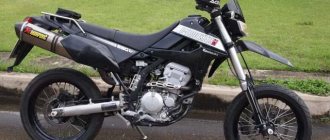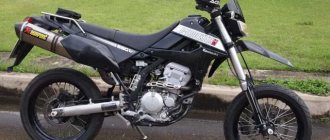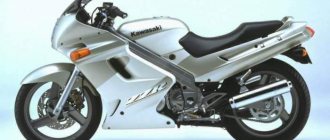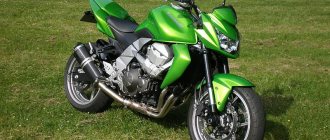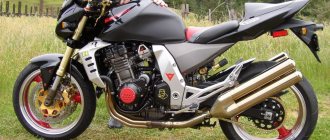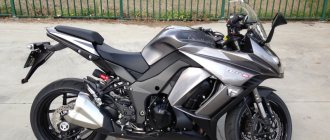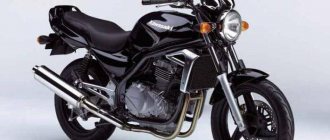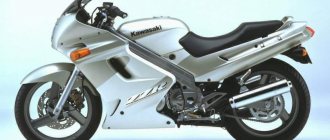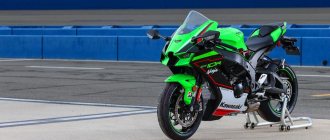A little history of D tracker 250
The model began production in 1999. Essentially, this is the same Kawasaki KLX 250, but with more powerful wheels, stiffer suspension and a stronger front brake.
Kawasaki KLX 250 - 1997 release.
Kawasaki D-Tracker 250 - 1997 release.
- A distinctive feature of the motorcycle is a single-cylinder four-stroke engine , equipped with a liquid cooling system, with a volume of 249 cubic meters .
- The power of the Kava is small - only 30 horsepower . But this is quite enough for “driving” around the city at night.
Since 2003, motorcycle production has been moved to Thailand.
Peculiarities
Riding this lightweight motard around town is a pleasure.
D-Tracker opens up completely new horizons for its owner. This is a great option for moving around city streets. Thanks to its compact size and sufficient cubic capacity, Kawasaki feels confident on city streets and does not linger in traffic jams.
Superbly built, a city slicker, distinguished by maneuverability and ease of control.
D-Tracker X
After the update, the motorcycle received a sharp wing.
Together with the KLX 250, the manufacturer also updated its closest relative, the D-Tracker X.
If before it looked almost the same as the KLX 250 , now the differences are visible on the front fender.
The color scheme of the motorcycle has also changed. Thus, the short and sharp fender of the bike in tricolor colors gives the design a stylish and dynamic look.
Main competitors
Kawasaki has collaborated with the Suzuki brand, so motorcycles from these brands are not competitors. But Honda provides significant competition to the Kawasaki 250 D Tracker. The Honda CRF 250L is a major contender in the small-capacity motorcycle market. Despite the fact that both bikes come from Japan, their differences are quite significant.
The Honda enduro motorcycle is positioned as a means of transportation for every day. Designed as a counter to the popular D-Tracker 250, the Honda CRF 250L has very similar features. Tank volume is 7.7 liters, 1-cylinder engine with 4 valves and fuel injection. But why do some motorcyclists consider it more powerful than the Kawasaki?
It's all about the engine, which the Honda bike got from the legendary line of sports CBR motorcycles. The manufacturer derated it and reconfigured it for better traction from the bottom. That is why reviews from motorcycle owners say that the Honda is more powerful and controllable. But the appearance is much better on the Kawasaki D-Tracker 250. It is a real city slicker. Bright colors and powerful appearance make it a home on the streets of the metropolis.
Specifications
The Kawasaki D-Tracker 250 will not leave anyone indifferent. Well, perhaps only those who are used to pushing to the fullest. This is the best option for those who prefer to leave home 15 minutes before the start of the working day - a motorcycle will not allow you to linger in traffic jams, confidently negotiating city traffic.
| Characteristic | Parameter |
| Motorcycle type | supermoto (motard) |
| Year of issue | 1998+ |
| engine's type | 1-cylinder, 4-stroke |
| Working volume | 249 cc cm. |
| Cooling | Liquid |
| Bore/Stroke | 72 x 61.2 mm |
| Compression ratio | 11,0:1 |
| Number of valves per cylinder | 4 valves, DOHC |
| Fuel supply system | carburetor, 1x Keihin CVK34 - 1998-2007, KLX250SF injector, 1x Keihin 34 mm - 2008+ (D-Tracker X) |
| Ignition type | CDI |
| Launch | electric starter |
| Maximum power | 30 hp at 8500 rpm - 1998-2007 23 hp. at 8500 rpm - 2008+ (D-Tracker X) |
| Maximum torque | 25.5 Nm at 7500 rpm - 1998-2007 21 Nm at 6500 rpm - 2008+ (D-Tracker X) |
| Transmission | 6-speed |
| type of drive | chain |
| Frame | steel half-duplex |
| Front suspension | 43mm inverted fork, 230mm travel |
| Rear suspension | Pendulum Uni-Trak with monoshock absorber, stroke - 205 mm |
| Front tire size | 110/70-17 |
| Rear tire size | 130/70-17 |
| Front brakes | Single 260 mm disc, 2-piston caliper (300 mm - 2008+) |
| Rear brakes | Single 220mm disc, 1-piston caliper (240mm - 2008+) |
| Overall dimensions (LxWxH) | 2065x790x1175 mm - 1998-2007 2130x795x1140 mm - 2008+ (D-Tracker X) |
| Seat height | 865 mm - 1998-2007 860 mm - 2008+ (D-Tracker X) |
| Wheelbase | 1435 mm - 1998-2007 1420 mm - 2008+ (D-Tracker X) |
| Gas tank capacity | 8.0 l (since 2008 - 7.7 l) 7.5 l - Japanese versions (1998-2007) |
| Maximum speed | 145 km/h |
| Acceleration to 100 km/h (0-100) | 8 sec |
| Motorcycle weight (curb) | 128 kg - 1998-2007 137 kg - 2008+ (D-Tracker X) |
- The single-cylinder engine provides sufficient thrust even at low speeds.
- The maximum speed of 149 km/h is enough to get everywhere. Comfortable speed is 120 km/h.
- The brake discs stop the motorcycle in a matter of seconds.
- 17-inch motard wheels are equipped with reinforced brake discs, which ensures additional driving safety.
There is a mini pouch on the rear fender for tools or documents.
Confidently maintaining speed and careful acceleration - all this is the merit of 30 horses that cheerfully carry their owner.
The narrowed chassis allows you to deftly maneuver between cars that are stuck for a long time in city traffic jams - it deftly moves through them like a bumblebee in a morning meadow.
Suspension
When buying this supermoto, you need to remember that this is not a real motocross motorcycle. It will not drive through good mud, but will get stuck in it.
The motorcycle suspension deserves special attention - it has become a little stiffer . Thanks to this quality, even speed bumps are not felt at average speed. The motorcycle also “walks” easily and naturally over rough terrain and broken roads. The only thing you should be wary of on the road are large potholes - 17-inch wheels won’t cope with them.
Despite the fact that the motorcycle can accelerate to 145–150 km/h, it is not worth taking risks, because after the speedometer needle shows 130 km/h, the Kawasaki D Tracker 250 begins to lose a lot of stability.
Technical features of Yamaha WR250R, Kawasaki KLX250S and Honda CRF250L motorcycles:
Engines for WR250R, KLX250S and CRF250L
If we talk about engines, the presented motorcycles have water-cooled engines with fans installed from the factory, a four-valve cylinder head and a volume of 250 cm3. Injector power supply system. But the power of the Yamaha WR250R is noticeably higher, 31 hp. versus 24 hp Kawasaki and 23 hp. at Honda. To be fair, on the Cava and Honda it is possible to suffocate the engine a little. And also on Kawasaki, the ability to install a kick starter can be considered a plus. In addition, in the KLX and CRF, the torque plateau is shifted towards lower revs, which is a definite plus for novice riders. The engine on the WR250R is nothing more than a sawed-off cylinder from the R1. And he loves to be spun. The frequency of servicing the engines of these motorcycles is quite rare. On their hard-core brethren, you'll change the piston, cylinder and then the bike several times before it's time to adjust the valves on the heroes of this article.
Pendants
Now about the pendants. The suspension on the Yamaha WR250R is head and shoulders better than the KLX and CRF. More suspension travel. Energy intensity is beyond praise. On a road with a lot of bumps, holes and stones, it allows you to move at a fairly high speed. At the same time, you feel like you are on smooth asphalt. There's also more adjustability on the WR250R. Kawasaki and Honda can't do that. You can immediately feel that the Yamaha has a modern suspension, with a diameter of 46 mm and a working stroke of 270 mm. Kawasaki has a suspension from the old KLX from the 90s, with a diameter of 43 mm and a working stroke of 255 mm. Honda still has 43 mm, but the stroke is even less, 250 mm and there are no adjustments at all.
Frame
Let's talk a little about frames. All motorcycles have a semi-duplex frame, but on the KLX and CRF it is steel, and on the Yamaha WR250R it is aluminum. The welding quality of motorcycles is at the proper level for the Japanese. I think it’s clear that the aluminum frame on the WR250R is more technologically advanced, lighter and torsionally rigid than on the KLX and CRF, but it is also noticeably more expensive to manufacture.
Weight
And in weight, Kawasaki loses to Yamaha. The curb weight of the KLX is 136 kg, versus 134 for the WR, which is also, in general, not at all small. But the fattest one is Honda. Curb weight is as much as 143 kg. But let me remind you that in these motorcycles reliability and durability, as well as comfort, are put at the forefront. And excess weight is an inevitable side effect.
Brakes
The brakes are about the same in efficiency. Except that on Yamaha the brake disc is floating. The diameters of the front brake discs on Yamaha and Kawasaki are 250 mm. On Honda it is 256 mm, and since 2017, it has also acquired ABS (in some trim levels). The rear of the Kawasaki KLX250S is even slightly larger than that of its opponents, 240 mm versus 230 for the Yamaha WR250R and 220 for the Honda CRF250L. The front calipers on all motorcycles are two-piston, the rear calipers are single-piston.
Tuning
Tidying up a 2008 motard.
Tidying up a 2011 motard.
The first thing that needs tuning is a modernized wing. Although it looks stylish, there is almost no practical side to it.
In bad weather, raindrops from the wheel reach the top headlight, which is unaesthetically displayed on the appearance of the wing. The dashboard is illuminated in a beautiful blue hue at night.
The saddle is quite a “passable log”; you can ride alone quite comfortably and you can even “throw” a passenger a short distance.
It sits quite comfortably in the passenger seat. Due to the balanced center of gravity, the motorcycle behaves even more stable.
Engine cooling
It is worth paying attention to the liquid cooling system of the engine - it is so harmoniously designed that even in the heat the pilot can safely travel long distances . Although the motorcycle, in principle, is not intended for long-distance travel. The six-speed gearbox provides the ability to perform various maneuvers on the road.
Another positive point: manufacturers took care of increasing the service life of the aluminum cylinder. It is coated with a special compound that reliably protects it from damage and ensures a tighter adhesion of the piston to the cylinder.
Moto No. 2 2008
Overcoming insurmountable obstacles, falling and getting up, going ahead, gritting your teeth - all this should be at least an episode in the life of every real man. The guys from the Sochi club Strollers MC took a risk and did something that no one had dared to do before - they crossed the Caucasus ridge on motorcycles. About this in the story of the club president.
What are the limits of my motorcycle? And what about mine when I’m driving?.. For a long time I couldn’t come up with a suitable test for my rare semi-trial Honda TLR250. And suddenly a crazy idea - to cross the Caucasus ridge, through the subtropical jungle along steep slopes, rocks and snowfields. The “catalyst” for leaving was a call from a friend nicknamed Bratka: “We’re leaving in three days.”
Here is our team: Roma on a Yamaha WR450R, Kepa on a Kawasaki Super Sherpa 250, Bratka and Abdula on two Yamaha Serow 225, Strela on a Honda XLR250 and Kot on a Suzuki Djebel 200. All are seasoned and experienced fighters, professional motorcycle tourists.
In trailers and pickup trucks we transported the equipment to Krasnaya Polyana to the parking lot of our comrade Yura. The assault on the Caucasus ridge is an enterprise that requires “covered rear”, so our friend and guide Roman sent a large canister of gasoline and a supply of food by helicopter to the cordon with the funny name Umpyr. Roma is the only one of us who has been to those dangerous lands (seven years ago he walked along the same route). Feeling all the responsibility for the mission entrusted to me, I carefully packed the satellite phone entrusted to me into my backpack.
Having overcome numerous cordons of the reserve, the territory of which we were entering, full of strength and energy we jumped out onto a picturesque alpine meadow. A barely noticeable path went under the “snow tongue” - a snow cap that does not melt even in summer. Moving along the white crust at a 45-degree incline is an almost impossible task. It was not possible to tack the section or take a detour and, using ropes, we moved forward: four “barge haulers” are harnessed to a towline and pull the tied bike up, and another pushes the motorcycle, leaning against the steering wheel... And suddenly I noticed a movement under the boot - from surprise my soul sank to my heels. He pulled out an unclassifiable animal from under his sole - something between a mole, a hamster and a rat. The creature may be small, but it is vicious - it was not possible to photograph it due to the increased bite of the animal.
The fight with the snow was exhausting, and we stopped to rest on the Aishkho ridge, where one mountain stream intersects with another. Fabulously beautiful place! Alas, it was not possible to immortalize the magnificent views and mountain tulips - the camera batteries treacherously ran out. It’s much worse that the battery in one of the Yamaha Serows ran out, the poor fellow had to turn around on a narrow path, coast to start and turn around again...
We took a rest and went downhill through the dense snow on the other side of the pass. We drove off - and in the next alpine meadow we congratulated each other on the unprecedented crossing of the Caucasus ridge - before us, no one had crossed it on motorcycles yet. We rejoiced early - we thought that the hardest part was over: there were only “flowers” - the “berries” were still waiting.
With every kilometer passed, the thin mountain stream along which we moved gradually turned into a full-flowing river. The team crossed small streams with a bang, but the rapid progress was stopped by a ridge of stones the size of a box to a minibus - a pile of them appeared in the mountains relatively recently, several hundred thousand years ago. Stopping in front of the obstacle, I immediately realized that these were the same gray-brown spots to the left and right of the river that I had noticed back when I was at home mapping out the route using Internet satellite photographs.
And suddenly Roman jumped into the river on a motorcycle! His strange act ended the dispute about where to go now - up the mountain or into the water. The river swallowed up the desperate man and dragged Roma, who was clinging to the steering wheel, along the bottom. The whole team caught the bike, but we were helpless. The willow helped to get the catch: Yamaha caught on its root.
There was somehow no desire to plunge into the fast stream again: the water temperature was only 4 degrees. They used a rope to cross; already on the other bank we rode across the snowfield, crossed a dangerous bridge over a seething river, and set up camp. Bread with goose pate, futile attempts to dry seven sets of clothes and shoes by a barely burning fire - this is how the first day of the extreme journey ended.
“Morning news reports” from those who woke up early and had time to look around. A bear was spotted on a nearby slope - this time, and the second, no less “joyful” news: the engines of two flooded “Yamas” (except for WR, one Serow sank) were filled with a cocktail of water and oil. Attempts to evaporate the water using a gas burner did not lead to anything. Roman contacted the rangers by satellite phone and asked them to bring a canister of any oil to the beginning of the trail. The brother, as the most experienced tourist, “quickly ran” after her - he covered 30 km of the mountain road in “just” seven hours.
We changed the oil and continued on our way. And almost immediately we entered a dense forest of 30-meter ancient fir trees. The happiness of detached merging with the miracle of nature did not last long - we had to return to the difficulties of existence: we walked, walked and again ran into the river. While setting up a rope crossing over a stormy stream, we remembered with quiet sadness that we had left (not forgotten, but deliberately left) our climbing carabiners at home - at their expense we had lightened our luggage. But it was precisely these “grams” that I needed to take with me!... But they didn’t spin – they made sliders from cans, plastic bottles, from everything that was at hand. Then we ran into the next river, we crossed it faster - we already had experience from previous crossings. Another “ambush” was waiting ahead - a huge ridge of boulders, between which the motorcycles simply got stuck. It’s okay, we sweated and passed.
By evening, my arms and legs no longer responded well to the commands of my falling asleep brain. The goblin kept diverting the path away from the headlights. No matter how hard they tried, they did not find either water (somehow the detachment left all the rivers and streams) or a place to camp, although they did not stop searching until complete darkness.
ѕNothing was served for breakfast. But they “ate up” with funny situations. Strela and Bratka, it turns out, were sleeping right on the path and, in order not to roll away in their sleep, they placed stones under the rug and tied their sleeping bags to the roots of the trees. The cat was generally sleeping with his feet resting on a tree - on the “foot brake”* Then something not at all funny happened: my motorcycle refused to start. This has happened before, but now I calcined the spark plug with dry alcohol and the engine came to life.
The third day was no easier: the road still required hellishly stressful “plowing” - you couldn’t relax. They created little joys for themselves: they happily swam in a mountain pool, made coffee over a fire - it was made from brushwood and bison dung (someone heard somewhere that the Bedouins do this). And again into battle - up a long zigzag 40-degree climb. But here Strela's XLR stopped starting.
The clouds were gathering, the first rare drops of rain promised to create a bobsleigh track on the merciless mountain slope. Not heeding friendly advice to abandon the motorcycle to the devil in the forest and continue on foot, Strela, gritting his teeth, pushed the bike up the hill. At the top of the hill awaited the prize - a flat forest path. For the first time in three days, we were able to drive along it, switching to second and third gears! Not paying attention to the rain and hail, they frolicked like children. Meanwhile, the detachment rushed through the places of former battles of the Sochi mountain rescue division with the fascist invaders. I stopped to look at the memorials and was no longer able to start the TLR: the motorcycle “ate” its fuel supply. With shouts and screams, I rushed to catch up with the expedition, finally caught up - I returned to the bike with a full tank of gasoline: my comrades did not abandon me in trouble, they shared fuel.
Suddenly, as in a fairy tale, the forest parted, and we found ourselves at the Umpyr cordon. Here we had hot food, warmth, beds with mattresses, a supply of gasoline and even a bathhouse. Happiness knew no bounds!.. And one more thing: this place is not easy. During the Great Patriotic War, the cordon was captured by the Nazis. Here lay the path along which the Nazis wanted to break through to Sochi hospitals, seize them and in such a vile way weaken our rear. Thanks to the courage and bravery of the Soviet soldiers, the enemy was not allowed into the health resort. On one of the rocks we came across a preserved inscription: “Beware of mines!” And the rangers said that deadly charges from that time can still be stumbled upon in the surrounding area...
In the morning, Strela once again turned around the perpetually deflating tire, and we used a handy tool - a shell casing from a German shell - to tighten the chains. We honestly divided the gasoline that had been delivered to Umpyr in advance, said goodbye to the hospitable hosts of the cordon and rushed to storm the Balkan ridge. Will something happen? In satellite photographs she looked unapproachable...
The completely tolerable path suddenly went under water. That's it, we've arrived! Once upon a time, a mudflow that struck downstream of the river collapsed a natural dam and raised the water level. Before my eyes, the unexpected happened: the Cat took a step to the side - and practically went under the water with his head. To avoid his fate, he made his way along the shore, hugging the rock and trying not to touch the water. Having made our way through thickets of ferns as tall as a man, we finally discovered a two-lane dirt road. Anticipating the final victory of the expedition, we set off. Some 30 km of controlled drifts - and here is Psebay. The national park guards stared at us in surprise. Hello civilization!
Sitting in a cafe, proclaiming toasts to ourselves and the common victory, we remembered how just a day ago we drank liters of melt water and, being hot, could not quench our thirst, how we were thrown into the “four points”, and we greedily swallowed the rarefied air, but it was difficult it was time to catch my breath, how my legs were paralyzed in the icy water, how Abdul, who forgot to take a hiking mat, crawled at night in an alpine meadow, trying to warm up, and Roma flooded the path with the blood of his broken legs... They were proud that no one had ever passed this route on a motorcycle and It's unlikely to stick around. They promised each other: never set foot there again. But something tells me: the Caucasus will see us again!
The travelers covered 112 km, 70 km of which were along the so-called “mountain trail,” that is, completely off-road in extreme alpine conditions.
Who is D'tracker 250 suitable for?
For oldies and motorcycle ladies, as well as for beginners who are just mastering the technique of this category.
The motorcycle seat is straight, without leaning forward or touristy “relaxation”, setting you up for active riding.
Thanks to its small cubic capacity and the necessary stability, the D-Trucker prevents bad thoughts from a crazy head from becoming reality. Although, as they say, there would be a desire. However, the motard is an excellent option for those who are looking for an easy-to-use and convenient vehicle that will not allow you to spend a lot of time in traffic jams.
Even a child can ride a motorcycle. In an urban environment, this moto has no equal. Therefore, we can say with confidence that the Kawasaki D Tracker 250 is an excellent trainer for the first steps on the two-wheeled path .
Minuses
But the motard also has disadvantages. First of all, this is the low power of the motorcycle. Experienced drivers say that they lack acceleration speed. It reaches a maximum of 90 km/h on long trips. The motorcycle can accelerate to 130 km/h, but only on very short sections of the road. On the other hand, this very specific bike is designed for certain needs, and if you buy it for something other than its intended purpose (for example, for touring or racing on the track), it is foolish to expect good performance from it.
When buying a Kawasaki D-Tracker 250, you need to remember that it is not a real dirt bike. He will not drive through the mud, but will get stuck in it. Another disadvantage is the transportation of only one driver. You can seat a passenger, but it will be difficult to travel with him. In the Kawasaki 250, the seat is not designed for two people, and the bike will go much slower.
The Kawasaki klx 250 D Tracker will undoubtedly perform at its best if you clearly understand why you are purchasing it and for what purpose. It is ideal for beginners and lovers of small cubic capacity. Lightweight, maneuverable, powerful two-wheeled transport will be a reliable means of transportation. If you want to go 130 or more, it won't suit you.
Advantages of a motorcycle
- Smooth acceleration is the first thing I would like to note. The motorcycle does not “rip” under itself. It accelerates to 100 km/h slowly and smoothly, which is extremely important for city conditions.
- The dynamics of the motard deserve special praise, because not every motorcycle in this category can be so maneuverable.
- Since the Kawasaki D Tracker 250 has motocross bikes in its pedigree, the D-Tracker feels great on rough terrain .
